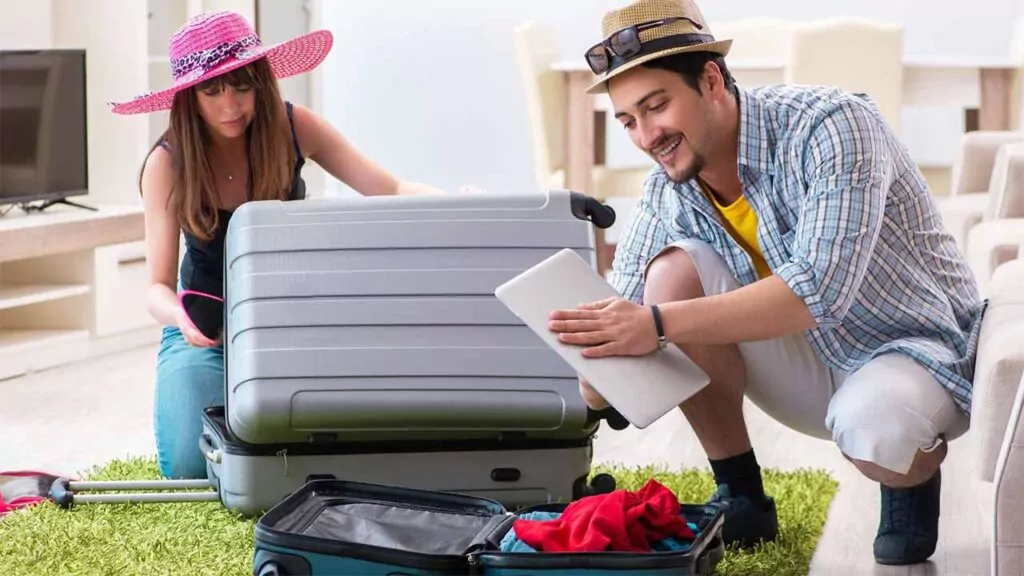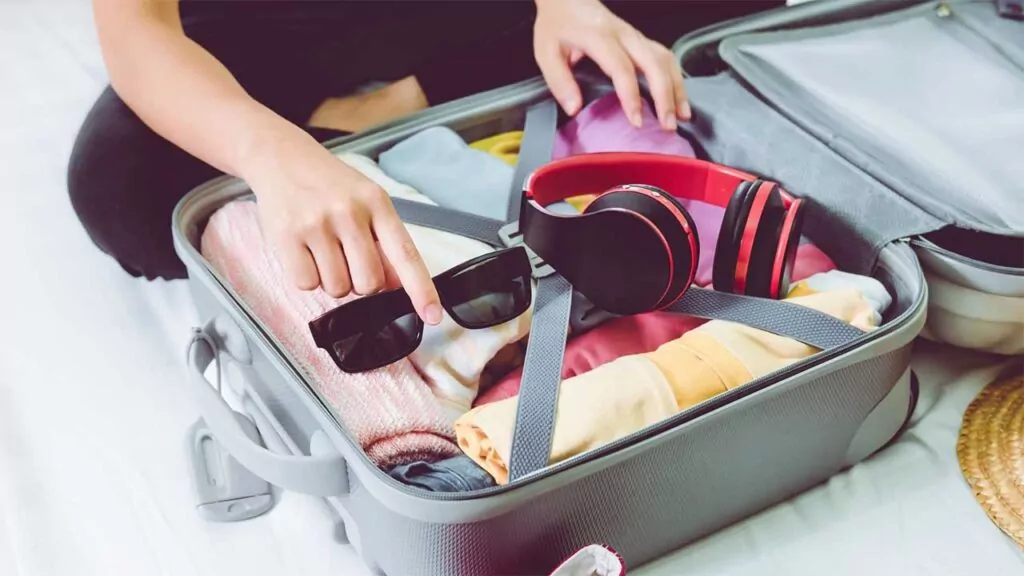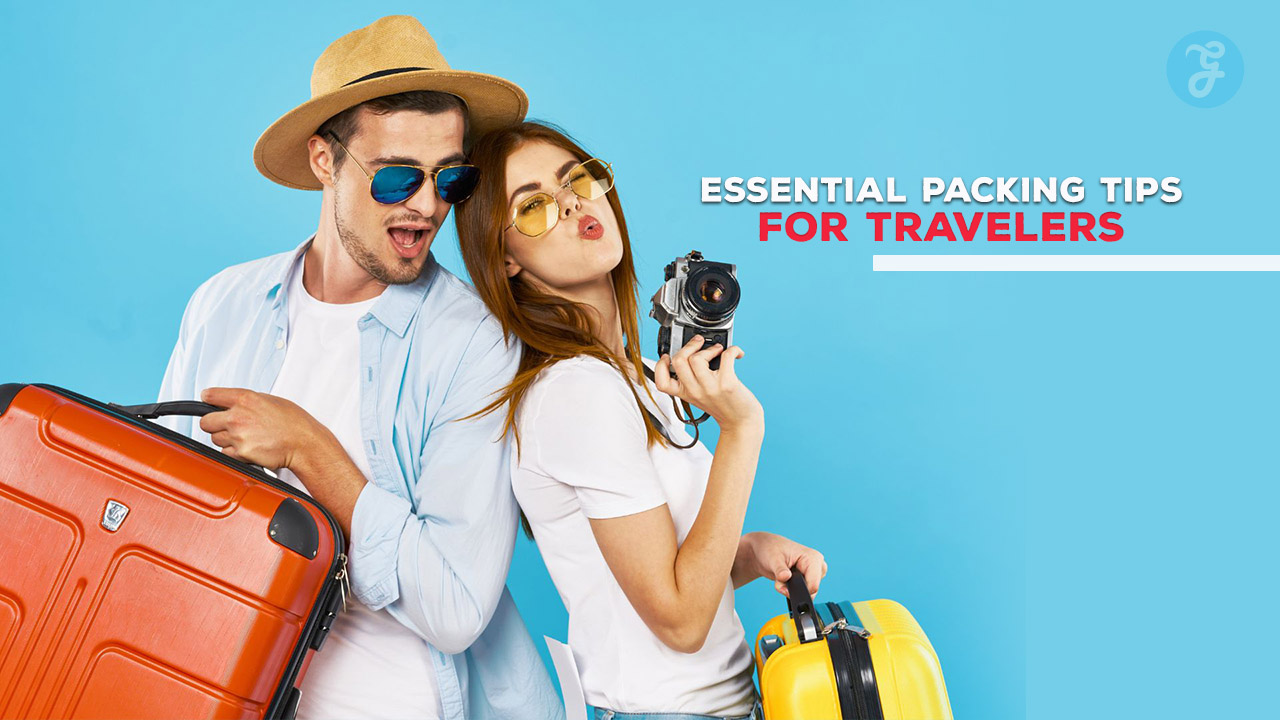Traveling is an exciting adventure, but packing for your trip can be stressful. Whether you’re planning a weekend getaway or a month-long journey, knowing how to pack efficiently can make your travels smoother and more enjoyable. This guide will walk you through 10 essential packing tips for travelers that will help you prepare for your next trip like a pro. From choosing the right luggage to organizing your belongings, these tips will ensure you have everything you need without overpacking.
1. Choose the Right Luggage
The foundation of smart packing starts with selecting the right luggage. Your choice of bags can make a big difference in how easily you can move around and how much you can bring.
Types of luggage
- Suitcases are great for longer trips or when you need to pack formal wear. Hard-shell suitcases offer better protection, while soft-sided ones can be expanded to fit more items.
- Backpacks are ideal for adventure travel or when you need to be hands-free. They’re versatile and easy to carry on various terrains.
- Duffel bags are perfect for short trips or as gym bags. They’re lightweight and can be squeezed into tight spaces.
- Carry-on bags are essential for keeping important items close and avoiding checked baggage fees on flights.
Factors to Consider When Choosing Luggage
- Trip duration: A weekend trip might only need a carry-on, while a two-week vacation could require a larger suitcase.
- Travel style: Are you hopping between cities or staying in one place? This affects whether wheels are necessary.
- Transportation: If you’re mainly taking planes, consider luggage that fits airline size restrictions.
- Durability: Invest in quality luggage that can withstand the rigors of travel.
- Weight: Remember, you’ll be lifting and carrying your bags. Lighter options can make travel easier.
Tips for luggage selection
- Measure before you buy: Always check the dimensions against airline restrictions if you plan to use it as a carry-on.
- Test the wheels: For wheeled luggage, make sure they roll smoothly and turn easily.
- Check the handles. Retractable handles should be sturdy and comfortable to grip.
- Look for compartments. Multiple pockets and sections can help with organization.
By choosing the right luggage, you set yourself up for packing success. The proper bag will make it easier to organize your belongings and transport them comfortably throughout your journey.
2. Make a packing list
Creating a packing list is a crucial step in preparing for any trip. It helps ensure you don’t forget essential items and prevents overpacking.
Benefits of Making a Packing List
- Reduces stress: You won’t have to worry about forgetting important items.
- Saves time: A list streamlines your packing process.
- Prevents overpacking: By sticking to your list, you’re less likely to throw in unnecessary items.
- It helps with organization. You can group similar items together on your list.
How to Create an Effective Packing List
- Start early: Begin your list at least a week before your trip to give yourself time to remember everything.
- Consider your destination: Think about the climate, cultural norms, and activities you’ll be doing.
- Check the weather forecast. This will help you pack appropriate clothing.
- List the essentials first: Start with must-have items like medications, travel documents, and chargers.
- Break it down by category: Separate your list into sections like clothing, toiletries, electronics, etc.
- Be specific: instead of “shirts,” list “3 t-shirts, 2 dress shirts.”
- Include often-forgotten items like a power bank, travel adapter, or first-aid kit.
Sample Packing List Categories
- Clothing: underwear, socks, shirts, pants, jackets, shoes, sleepwear
- Toiletries: toothbrush, toothpaste, deodorant, shampoo, soap, sunscreen
- Electronics: phone, charger, camera, laptop, power bank
- Documents: passport, visa, travel insurance, boarding passes, hotel reservations
- Accessories: sunglasses, hat, watch, jewelry
- Miscellaneous: books, snacks, water bottle, travel pillow
Tips for Using Your Packing List
- Customize for each trip: Adjust your list based on the specific needs of each journey.
- Keep a digital copy. Store your list on your phone or in the cloud for easy access.
- Check items off as you pack. This gives you a visual confirmation of your progress.
- Review before leaving: Do a final check against your list before closing your luggage.
A well-thought-out packing list is your roadmap to organized and stress-free travel preparation. It ensures you have everything you need without the burden of excess baggage.
3. Pack versatile clothing
Choosing versatile clothing is key to packing light while still having appropriate outfits for various occasions. The goal is to create a travel wardrobe that maximizes outfit combinations with minimal pieces.
Benefits of Packing Versatile Clothing
- Lighter luggage: Fewer items mean less weight to carry.
- More outfit options: Versatile pieces can be mixed and matched for different looks.
- Adaptability: You’re prepared for unexpected events or weather changes.
- Easier decision-making: A coordinated wardrobe simplifies choosing daily outfits.
Characteristics of Versatile Clothing
- Neutral colors: Items in colors like black, white, navy, or beige can be easily combined.
- Wrinkle-resistant fabrics: Look for materials that don’t crease easily, like polyester blends or merino wool.
- Layerable pieces: Thin layers allow for adaptability to different temperatures.
- Multifunctional items: pieces that can be dressed up or down for various occasions.
Essential Versatile Clothing Items
- Basic t-shirts: Plain tees in neutral colors can be worn alone or layered.
- button-up shirt: can be casual or dressy, depending on how it’s styled.
- Comfortable jeans or trousers: Choose a dark wash for more formal versatility.
- Lightweight jacket or cardigan: for layering and warmth.
- versatile dress or skirt: can be dressed up or down with different accessories.
- Comfortable walking shoes: They should be suitable for various activities and match multiple outfits.
Tips for Packing Versatile Clothing
- Plan your outfits: Think about how each piece can be used in multiple combinations.
- Choose a color scheme. Stick to a palette that allows easy mixing and matching.
- Pack clothes that can be layered. This allows for adaptation to different weather conditions.
- Limit shoes: Aim for no more than three pairs—comfortable walking shoes, dress shoes, and sandals or boots, depending on your destination.
- Accessorize: Scarves, jewelry, or ties can change the look of an outfit without taking up much space.
- Consider the activities: Pack items suitable for the activities you have planned.
Example of a Versatile Travel Wardrobe (1 Week)
- 3 t-shirts (2 neutral, 1 colorful)
- 1 button-up shirt
- 1 pair of jeans
- 1 pair of comfortable trousers
- 1 dress (women) or 1 extra shirt (men)
- 1 lightweight jacket or cardigan
- 1 pair of comfortable walking shoes
- 1 pair of dressier shoes
- 7 sets of undergarments
- 1-2 accessories (scarf, statement necklace, or tie)
This combination can create numerous outfits suitable for casual sightseeing, nice dinners, or unexpected invitations.
By focusing on versatile clothing, you can significantly reduce the amount you pack while ensuring you’re prepared for various situations. This approach not only lightens your load but also simplifies your daily decisions while traveling, allowing you to focus more on enjoying your trip.
4. Roll your clothes

One of the most effective techniques for maximizing space in your luggage is to roll your clothes instead of folding them. This method not only saves space but also helps reduce wrinkles in your garments.
Benefits of Rolling Clothes
- Space-saving: Rolling compresses clothes, allowing you to fit more in your luggage.
- Wrinkle reduction: Properly rolled clothes are less likely to develop deep creases.
- Easy organization: Rolled clothes are easier to see and access in your luggage.
- Versatility: This method works for most types of clothing.
How do you roll different types of clothing?
T-shirts and tank tops
- Lay the shirt flat.
- Fold in the sleeves.
- Fold the shirt in half vertically.
- Starting from the bottom, tightly roll the shirt up to the collar.
Pants and jeans
- Fold the pants in half lengthwise.
- Fold in half again (optional, for longer pants).
- Starting from the waist, tightly roll towards the cuffs.
Dresses and skirts
- Fold the dress or skirt in half vertically.
- Roll from the bottom hem up to the waist or shoulders.
Button-Up Shirts
- Button up the shirt and lay it face down.
- Fold in the sides, creating a long rectangle.
- Fold in the arms.
- Roll from the bottom up to the collar.
Socks and underwear
- For socks, lay them flat and roll from toe to top.
- For underwear, simply fold in half and roll.
Tips for Effective Clothes Rolling
- Smooth out wrinkles: As you roll, keep the fabric taut to prevent wrinkles.
- Use rubber bands: Secure rolled items with rubber bands to keep them compact.
- Roll similar items together: Group like items (e.g., all t-shirts) for easier unpacking.
- Place heavier-rolled items at the bottom. This creates a stable base in your luggage.
- Use rolled clothes as fillers. Tuck small, rolled items into your shoes or the corners of your bag.
Combining rolling with other packing methods
While rolling is effective for many items, some pieces may benefit from other techniques:
- Folding: Bulky items like sweaters or jackets might be better folded.
- Bundle wrapping: For longer trips, consider this method where clothes are wrapped around a core object.
- Packing cubes: Use packing cubes to organize rolled clothes by type or outfit.
When not to roll?
While rolling works for most clothing, there are a few exceptions:
- Formal wear: Suits and delicate dresses might be better folded or packed in garment bags.
- Very bulky items: Large sweaters or winter coats may take up less space when compressed flat.
- Easily wrinkled fabrics: Some materials, like linen, may need special folding techniques to prevent excessive wrinkling.
Rolling your clothes is a simple yet effective way to maximize space in your luggage and keep your clothes in good condition during travel. By mastering this technique, you can pack more efficiently, spend less time worrying about wrinkles and enjoy your trip more.
5. Use packing cubes
Packing cubes are small, lightweight containers that help organize your belongings within your luggage. These versatile tools have become increasingly popular among travelers for their ability to streamline the packing process and keep items organized throughout a trip.
Benefits of Using Packing Cubes
- Organization: Keep similar items together and easily accessible.
- Space optimization: compress clothes to fit more in your luggage.
- Easier unpacking: Simply transfer cubes from luggage to drawers at your destination.
- Cleanliness: Separate clean and dirty clothes easily.
- Stress reduction: Know exactly where everything is in your bag.
Types of Packing Cubes
- Standard cubes: rectangular shapes in various sizes for general use.
- Compression cubes: Feature an extra zipper to compress contents further.
- Garment folders are designed to keep dress shirts and pants wrinkle-free.
- Shoe bags are specially designed to contain shoes and protect other items.
- Wet bags: waterproof cubes for swimwear or toiletries.
How to Use Packing Cubes Effectively?
- Choose the right sizes: Mix and match cube sizes to fit your luggage and needs.
- Categorize your items: Assign each cube a purpose (e.g., tops, bottoms, underwear).
- Roll or fold: Either method works with packing cubes; choose based on your preference and the type of clothing.
- Fill completely: Stuff cubes to capacity to prevent items from shifting.
- Label your cubes: Use luggage tags or labels to easily identify contents.
- Stack strategically: Place heavier cubes at the bottom of your luggage.
Packing Cube Organization Ideas
- By outfit: Pack complete outfits together for each day of your trip.
- By person: In shared luggage, assign different color cubes to each family member.
- By activity: Separate cubes for beach wear, hiking gear, or evening outfits.
- By weather: Organize clothes for different climates if your trip involves varied destinations.
Tips for Maximizing Packing Cube Efficiency
- Use a mix of cube sizes: smaller cubes for socks and underwear, larger ones for bulkier items.
- Compress air out: Squeeze out excess air before zipping cubes closed.
- Use cubes as a dirty laundry bag: Designate one cube for used clothes during your trip.
- Pack a foldable cube: Bring an empty, foldable cube for souvenirs or laundry.
- Consider clear cubes. Transparent sides make it easier to see contents without opening.
Alternatives to Packing Cubes
While packing cubes is highly effective, there are other options for organizing your luggage:
- Ziploc bags are a budget-friendly alternative, especially good for compressing clothes.
- Vacuum bags are ideal for bulky items like jackets but require access to a vacuum for repacking.
- Backpackers frequently use stuff sacks, which are small, lightweight bags.
- Mesh bags: Allow for visibility and breathability.
Choosing the Right Packing Cubes
When selecting packing cubes, consider:
- Material: Nylon and polyester are durable and lightweight.
- Size variety: Look for sets with multiple sizes for versatility.
- Compression features: If space is at a premium, compression cubes can be beneficial.
- Durability: Check for reinforced seams and quality zippers.
- Weight: Ultralight cubes are best for travel, especially for carry-on-only trips.
Packing cubes are a game-changer for many travelers. They transform the interior of your luggage from a jumbled mess into an organized system. By using packing cubes, you can pack more efficiently, find items quickly, and maintain organization throughout your journey. Whether you’re a frequent traveler or an occasional vacationer, incorporating packing cubes into your travel routine can significantly enhance your packing experience and overall trip enjoyment.
6. Minimize toiletries
Toiletries can take up a significant amount of space and weight in your luggage. By minimizing and optimizing your toiletries, you can save space, comply with airline regulations, and still maintain your personal care routine while traveling.
Benefits of Minimizing Toiletries
- Save space: More room for other essentials or souvenirs.
- Reduce weight: lighter luggage is easier to carry and may avoid excess baggage fees.
- Comply with airline regulations: Avoid issues with liquid restrictions in carry-on bags.
- Simplify your routine: Focus on essential products for your trip.
Essential Toiletries to Pack
- Toothbrushes and toothpastes
- Deodorant
- Shampoo and conditioner
- Body wash or soap
- Moisturizer
- Sunscreen
- Any necessary medications
- Basic first-aid items (band-aids, pain relievers)
Tips for Minimizing Toiletries
- Use travel-sized containers: Transfer your products into 3.4 oz (100 ml) bottles for carry-on compliance.
- Opt for solid products: Consider solid shampoo bars, soap bars, and stick deodorants to avoid liquid restrictions.
- Pack multi-use products: Choose items that serve multiple purposes, like a shampoo/body wash combo or a tinted moisturizer with SPF.
- Rely on hotel amenities: Many accommodations provide basic toiletries, so you might not need to pack items like soap or shampoo.
- Pack sample sizes: Collect samples from beauty stores or subscription boxes for one-time use on short trips.
- Consider buying at your destination. For longer trips, consider purchasing full-size toiletries upon arrival.
- Use contact lens cases: These tiny containers are perfect for small amounts of creams or lotions for short trips.
Organizing Your Toiletries
- Use a clear, quart-sized bag. This is required for carry-on liquids and makes security checks easier.
- Invest in a good toiletry bag. Look for one with multiple compartments and a hook for hanging.
- Separate liquids: Keep potentially leaky items in a separate, sealed bag.
- Pre-pack a toiletry kit: Keep a travel set always ready to grab and go.
Eco-Friendly Toiletry Options
- Bamboo toothbrushes are a sustainable alternative to plastic toothbrushes.
- Refillable containers: Invest in high-quality, reusable travel bottles.
- Shampoo and conditioner bars: These solid products last longer and eliminate plastic waste.
- Reusable cotton pads: for makeup removal or applying toner.
- Menstrual cups are a space-saving and eco-friendly alternative to disposable products.
By minimizing your toiletries, you not only save space and weight in your luggage, but you also simplify your travel routine. This approach allows you to focus more on enjoying your trip and less on managing an extensive array of products.
7. Pack a portable charger
In our increasingly connected world, keeping our devices charged while traveling is crucial. A portable charger (also known as a power bank) is an essential item that can save you from the stress of a dead battery when you need your device most.
Benefits of Packing a Portable Charger
- Always connected: Ensure your devices never run out of power during long travel days.
- Emergency preparedness: Keep your phone charged for unexpected situations.
- Convenience: Charge your devices on the go without searching for outlets.
- Multiple device charging: Most power banks can charge several devices at the same time.
Choosing the Right Portable Charger
When selecting a portable charger, consider the following factors:
- Capacity: Measured in mAh (milliamp hours). A higher capacity means more charges, but also more weight.
- 5,000 mAh: good for 1-2 phone charges
- 10,000 mAh: Can charge most phones 3–4 times
- 20,000 mAh and above: ideal for tablets and multiple devices
- Output: Look for chargers with at least 2A output for faster charging.
- Input: A higher input means the power bank itself charges faster.
- Size and weight: balance capacity with portability based on your needs.
- Number of ports: Multiple ports allow charging several devices at once.
- Technology: Some power banks offer features like quick charging or wireless charging.
Top Features to Look For
- Pass-through charging: the ability to charge the power bank and your devices simultaneously.
- Auto on/off: Saves battery by turning off when devices are fully charged.
- LED indicators: Show the remaining battery level of the power bank.
- Built-in cables are convenient for reducing the number of cords you need to carry.
- Airline compliance: Ensure it meets airline regulations (usually under 27,000 mAh or 100 Wh).
Tips for Using Portable Chargers While Traveling
- Charge it fully before your trip. Start with a full power bank.
- Carry the right cables: Bring short cables for each of your devices.
- Use it strategically. Charge your devices when you have downtime, such as during meals or transportation.
- Keep it easily accessible. For quick access, store it in your bag’s outer pocket.
- Check airline regulations: Some airlines require power banks in carry-on luggage.
- Protect from extreme temperatures: Avoid leaving it in very hot or cold environments.
Additional Power-Saving Tips
- Use airplane mode: When not needed, this can significantly extend battery life.
- Lower screen brightness: dimming your screen uses less power.
- Close background apps: apps running in the background drain battery.
- Bring a plug adapter. For international travel, ensure you can charge your power bank.
Safety Considerations
- Buy from reputable brands: Avoid cheap, no-name brands that might pose safety risks.
- Check for certification: Look for UL, CE, or RoHS certifications.
- Avoid extreme heat: Don’t leave your power bank in direct sunlight or hot cars.
- Inspect regularly: Check for any signs of damage or swelling.
Packing a portable charger is a simple yet effective way to ensure you stay connected and prepared throughout your travels. By choosing the right power bank and using it wisely, you can avoid the inconvenience and potential danger of running out of battery power when you need it most.
8. Use travel-sized containers

When it comes to packing efficiently, using travel-sized containers for your liquids and creams can make a significant difference. They help you comply with airline regulations and save luggage space and weight.
Benefits of Using Travel-Sized Containers
- Comply with airline regulations: Most airlines restrict liquids in carry-on bags to 3.4 oz (100 ml) containers.
- Save space: Smaller containers take up less room in your luggage.
- Reduce weight: Carrying only what you need for your trip lightens your load.
- Prevent spills: Properly designed travel containers are less likely to leak.
- Customization: Fill containers with your preferred products rather than relying on hotel amenities.
Types of Travel-Sized Containers
- Squeeze bottles: ideal for shampoo, conditioner, and body wash.
- Spray bottles are perfect for toners, setting sprays, or DIY fresheners.
- Jars: Great for thicker products like face creams or hair masks.
- Contact lens cases: excellent for small amounts of products for short trips.
- Stick containers: for solid products like deodorant or sunscreen sticks.
- Toothpaste tablets are a space-saving alternative to traditional toothpaste tubes.
- Pill organizers: not just for medication but also for small amounts of powders or creams.
How to fill travel containers
- Use a small funnel. This helps prevent spills when transferring liquids.
- Label your containers: Use a permanent marker or labels to identify the contents.
- Don’t overfill: Leave some space to prevent leakage due to pressure changes during flights.
- Clean thoroughly between uses. Ensure the old product is completely removed before refilling.
- Test for leaks: Before packing, close the container and turn it upside down to check for leaks.
Tips for Using Travel-Sized Containers
- Buy a set: Look for a set of containers in various sizes to suit different needs.
- Opt for silicone: silicone containers are durable, flexible, and easy to clean.
- Consider solid alternatives: Solid shampoo bars, soap, and toothpaste tablets save even more space.
- Pre-pack a travel set: Keep a set of travel containers always ready to go.
- Use a clear toiletry bag. This makes security checks easier and helps you see all your items at a glance.
- Pack strategically: For security, place liquids in an easily accessible part of your luggage.
DIY Travel-Sized Products
- Moisturizer: Mix your favorite lotion with a few drops of facial oil in a small jar.
- Toner: Fill a small spray bottle with rose water or diluted apple cider vinegar.
- Hand sanitizer: Mix aloe vera gel with a few drops of tea tree oil in a small squeeze bottle.
- Dry shampoo: Fill a salt shaker with cornstarch or arrowroot powder.
- Toothpowder: Mix baking soda with a drop of peppermint essential oil in a small jar.
Eco-Friendly Considerations
- Invest in quality, reusable containers. Avoid disposable, travel-sized products.
- Look for refillable options at your destination. Some hotels and stores offer refill stations.
- Choose biodegradable products; in the event of spills, these are less harmful to the environment.
- Opt for plastic-free containers: Look for glass, metal, or bamboo options.
Storing travel containers at home
- Keep them clean and dry. Prevent mold growth by ensuring containers are completely dry before storing.
- Store in a cool, dry place. Avoid bathrooms where humidity can affect the products.
- Use a dedicated storage box. Keep all your travel containers together for simple packing.
- Check expiration dates: Replace products in your travel kit regularly to ensure they’re still effective.
Using travel-sized containers is a simple yet effective way to streamline your packing process. By bringing only the amount of product you need, you can travel lighter, move through security checks easier, and still maintain your personal care routine while away from home.
9. Plan for Laundry
When traveling for extended periods, planning for laundry can significantly reduce the amount of clothing you need to pack. This strategy allows you to pack lighter and wear your favorite outfits multiple times during your trip.
Benefits of Planning for Laundry
- Pack less: Bring fewer clothes and save space in your luggage.
- Stay fresh: Wear clean clothes throughout your trip.
- Extend wear: Get more use out of your favorite travel outfits.
- Save money: Avoid excess baggage fees by packing lighter.
- Be prepared. Handle unexpected spills or stains during your trip.
Laundry Options While Traveling
- Hotel laundry service is convenient but often expensive.
- Self-service laundromats are cost-effective and available in many locations.
- Portable washing methods: hand-washing in a sink or using a portable washer.
- Laundry services: Some cities offer wash-and-fold services or laundry pickup.
- Airbnb with washer: Book accommodations with laundry facilities for longer stays.
What to Pack for Doing Laundry?
- Travel-sized detergent: Bring powder, sheets, or small liquid containers.
- Stain remover pen or wipes: for quick spot cleaning.
- Portable clothesline: To hang clothes to dry in your room.
- Sink stopper: useful for washing clothes in a hotel sink.
- Quick-dry towel: To remove excess water from clothes after washing.
- Mesh laundry bag: To keep dirty clothes separate from clean ones.
Tips for Doing Laundry While Traveling
- Choose quick-dry fabrics: Pack clothes made from materials that dry quickly, like synthetic blends.
- Wash small loads frequently. This is easier than doing one big load and waiting for everything to dry.
- Use bathroom amenities: Shampoo or body wash can work as laundry detergent in a pinch.
- Dry clothes overnight: Hang wet clothes before bed to dry by morning.
- Use the shower rod. If you don’t have a clothesline, hang clothes on hangers on the shower rod.
- Rotate your wardrobe: wear each item multiple times before washing.
Hand-Washing Clothes in a Hotel Sink
- Fill the sink with warm water and add a small amount of detergent.
- Submerge and gently agitate clothes.
- Let them soak for 15–30 minutes.
- Drain the soapy water and rinse the clothes thoroughly with clean water.
- Gently squeeze out excess water (don’t wring, as this can damage fabrics).
- Roll clothes in a towel to remove more water.
- Hang to dry.
Drying Clothes in a Hotel Room
- Use hangers: hang clothes on the shower rod or in the closet.
- Lay flat: Place delicate items flat on a towel to dry.
- Use the hairdryer for quick spot drying, especially on seams and waistbands.
- Position near air vents: Take advantage of the room’s air circulation.
- Avoid direct sunlight. This can fade colors, especially for darker clothes.
Choosing Laundry-Friendly Travel Clothes
- Opt for wrinkle-resistant fabrics. Materials like polyester, nylon, or wool resist wrinkles.
- Choose dark colors: They hide stains better and require less frequent washing.
- Pack versatile pieces: Items that can be dressed up or down reduce the need for multiple outfits.
- Consider odor-resistant fabrics: Some materials, like merino wool, naturally resist odors.
Eco-Friendly Laundry Tips
- Use biodegradable detergent. It is better for the environment, especially when traveling in nature.
- Washing in cold water saves energy and is gentler on clothes.
- Air-dry when possible. Avoid energy-consuming dryers.
- Spot clean: Address small stains immediately to avoid full washes.
Planning for laundry is a key strategy for packing light and traveling comfortably for extended periods of time. No matter how long you’re away from home, you can enjoy your trip with a lighter suitcase and a fresh wardrobe by incorporating these tips.
10. Leave room for souvenirs
When packing for a trip, it’s easy to focus solely on what you need to bring. However, it’s equally important to consider what you might want to bring back. Leaving room for souvenirs ensures you can return home with treasured mementos of your travels without the stress of overpacked luggage.
Benefits of Leaving Room for Souvenirs
- Flexibility: the freedom to purchase items that catch your eye during your trip.
- Avoid overpacking: Prevent the need to buy an extra bag or pay for overweight luggage.
- Reduce stress: There is no need to worry about fitting purchases into your luggage.
- Support local economies: Feel free to buy from local artisans and businesses.
- Preserve memories: Bring home tangible reminders of your travel experiences.
How do you create space for souvenirs?
- Pack light: Start by following the other packing tips to minimize your initial luggage.
- Bring an expandable suitcase. Some luggage has zippers that allow for extra space.
- Pack a foldable bag: Bring a lightweight, collapsible bag for extra carrying capacity.
- Wear bulky items: On the return trip, wear your heaviest clothes to free up luggage space.
- Use vacuum bags to compress clothes to create more room in your suitcase.
- Plan to discard: Pack items you intend to leave behind, like old clothes or finished books.
Types of Souvenirs to Consider
- Local crafts: handmade items that represent the local culture.
- Food and drink: non-perishable local specialties (check customs regulations).
- Clothing or accessories: unique pieces that reflect local fashion or traditions.
- Art: small paintings, prints, or sculptures from local artists.
- Books: travel guides, local literature, or coffee table books about the destination.
- Photography: While not physical items, leave memory card space for photos.
- Jewelry: small, valuable pieces that don’t take up much space.
- Home decor: small items like coasters, magnets, or decorative plates.
- Toys or games: fun items that represent the local culture, great for kids or as gifts.
- Beauty products: local skincare or cosmetics unique to the region.
Tips for Buying Souvenirs
- Wait until the end: Make major purchases towards the end of your trip to avoid carrying them around.
- Consider practicality: Choose items you’ll actually use or display at home.
- Check customs regulations. Ensure you can legally bring items back to your country.
- Look for unique items: Seek out souvenirs that truly represent the place you’ve visited.
- Bargain respectfully: In many places, bargaining is expected but always be polite.
- Keep receipts: You may need these for customs or tax refunds.
- Think about fragility. Consider how you’ll transport delicate items safely.
Packing Souvenirs for the Return Trip
- Use soft items as padding. Wrap fragile souvenirs in clothes for protection.
- Utilize empty spaces: Fill shoes with small, sturdy items.
- Keep valuable items with you: Pack expensive or irreplaceable souvenirs in your carry-on.
- Distribute the weight evenly. Balance heavy items throughout your luggage.
- Use original packaging: If available, original boxes often provide the best protection.
- Consider shipping: For large or heavy items, shipping directly home might be easier.
Souvenir Alternatives
- Take photos. Capture memories without taking up luggage space.
- Collect free mementos: Keep ticket stubs, maps, or pressed flowers as reminders.
- Start a travel journal. Write about your experiences instead of buying physical items.
- Buy digital souvenirs: Purchase e-books, digital art, or music from local artists.
- Make a photo book: Create a customized book of your travel photos after returning home.
Eco-Friendly Souvenir Shopping
- Choose sustainable materials: Look for items made from renewable or recycled resources.
- Avoid products from endangered species. Ensure your purchases don’t harm local wildlife.
- Buy from local artisans: Support the local economy and reduce transport-related emissions.
- Opt for minimal packaging. Choose items with less plastic or unnecessary wrapping.
- Consider experiential souvenirs: Pay for experiences like cooking classes or tours instead of physical items.
By leaving room for souvenirs, you give yourself the freedom to fully immerse yourself in the local culture and bring home meaningful reminders of your travels. This approach not only enhances your travel experience but also ensures you return with tangible memories that will last a lifetime.
Conclusion
Mastering the art of packing is a valuable skill that can significantly enhance your travel experience. By following these 10 essential packing tips, you can travel more efficiently, comfortably, and with less stress:
- Choose the right luggage.
- Make a packing list.
- Pack versatile clothing.
- Roll your clothes.
- Use packing cubes.
- Minimize toiletries
- Pack a portable charger.
- Use travel-sized containers.
- Plan for laundry.
- Leave room for souvenirs.
Remember, the key to successful packing is finding the right balance between being prepared and packing light. It’s about only bringing what you need and not carrying extra baggage.
As you apply these tips, you’ll likely develop your own personal packing style and preferences. Don’t be afraid to experiment with different techniques to find what works best for you. With practice, packing for your trips will become second nature, allowing you to focus more on the excitement of your upcoming adventure than the stress of preparation.
Happy travels, and may your journeys be as smooth and enjoyable as your efficiently packed luggage!





























